Phase-resetting curves determine synchronization, phase locking, and clustering in networks of neural oscillators
- PMID: 19386918
- PMCID: PMC2765798
- DOI: 10.1523/JNEUROSCI.0426-09.2009
Phase-resetting curves determine synchronization, phase locking, and clustering in networks of neural oscillators
Abstract
Networks of model neurons were constructed and their activity was predicted using an iterated map based solely on the phase-resetting curves (PRCs). The predictions were quite accurate provided that the resetting to simultaneous inputs was calculated using the sum of the simultaneously active conductances, obviating the need for weak coupling assumptions. Fully synchronous activity was observed only when the slope of the PRC at a phase of zero, corresponding to spike initiation, was positive. A novel stability criterion was developed and tested for all-to-all networks of identical, identically connected neurons. When the PRC generated using N-1 simultaneously active inputs becomes too steep, the fully synchronous mode loses stability in a network of N model neurons. Therefore, the stability of synchrony can be lost by increasing the slope of this PRC either by increasing the network size or the strength of the individual synapses. Existence and stability criteria were also developed and tested for the splay mode in which neurons fire sequentially. Finally, N/M synchronous subclusters of M neurons were predicted using the intersection of parameters that supported both between-cluster splay and within-cluster synchrony. Surprisingly, the splay mode between clusters could enforce synchrony on subclusters that were incapable of synchronizing themselves. These results can be used to gain insights into the activity of networks of biological neurons whose PRCs can be measured.
Figures


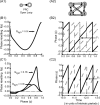
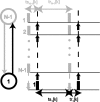



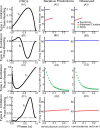
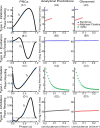

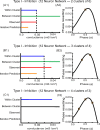
Similar articles
-
Existence and stability criteria for global synchrony and for synchrony in two alternating clusters of pulse-coupled oscillators updated to include conduction delays.Math Biosci. 2024 Dec;378:109335. doi: 10.1016/j.mbs.2024.109335. Epub 2024 Nov 2. Math Biosci. 2024. PMID: 39491588
-
A mean field theory for pulse-coupled neural oscillators based on the spike time response curve.J Neurophysiol. 2025 Jun 1;133(6):1630-1640. doi: 10.1152/jn.00045.2025. Epub 2025 Apr 29. J Neurophysiol. 2025. PMID: 40298916 Free PMC article.
-
Functional phase response curves: a method for understanding synchronization of adapting neurons.J Neurophysiol. 2009 Jul;102(1):387-98. doi: 10.1152/jn.00037.2009. Epub 2009 May 6. J Neurophysiol. 2009. PMID: 19420126 Free PMC article.
-
Neurons as oscillators.J Neurophysiol. 2016 Dec 1;116(6):2950-2960. doi: 10.1152/jn.00525.2015. Epub 2016 Sep 28. J Neurophysiol. 2016. PMID: 27683887 Free PMC article. Review.
-
Pulse coupled oscillators and the phase resetting curve.Math Biosci. 2010 Aug;226(2):77-96. doi: 10.1016/j.mbs.2010.05.001. Epub 2010 May 10. Math Biosci. 2010. PMID: 20460132 Free PMC article. Review.
Cited by
-
How synaptic function controls critical transitions in spiking neuron networks: insight from a Kuramoto model reduction.Front Netw Physiol. 2024 Aug 9;4:1423023. doi: 10.3389/fnetp.2024.1423023. eCollection 2024. Front Netw Physiol. 2024. PMID: 39185374 Free PMC article.
-
Cellularly-driven differences in network synchronization propensity are differentially modulated by firing frequency.PLoS Comput Biol. 2011 May;7(5):e1002062. doi: 10.1371/journal.pcbi.1002062. Epub 2011 May 19. PLoS Comput Biol. 2011. PMID: 21625571 Free PMC article.
-
Predicting the responses of repetitively firing neurons to current noise.PLoS Comput Biol. 2014 May 8;10(5):e1003612. doi: 10.1371/journal.pcbi.1003612. eCollection 2014 May. PLoS Comput Biol. 2014. PMID: 24809636 Free PMC article.
-
Phase response curve analysis of a full morphological globus pallidus neuron model reveals distinct perisomatic and dendritic modes of synaptic integration.J Neurosci. 2010 Feb 17;30(7):2767-82. doi: 10.1523/JNEUROSCI.3959-09.2010. J Neurosci. 2010. PMID: 20164360 Free PMC article.
-
Multi-scale modeling in biology: how to bridge the gaps between scales?Prog Biophys Mol Biol. 2011 Oct;107(1):21-31. doi: 10.1016/j.pbiomolbio.2011.06.004. Epub 2011 Jun 23. Prog Biophys Mol Biol. 2011. PMID: 21704063 Free PMC article. Review.
References
-
- Acker CD, Kopell N, White JA. Synchronization of strongly coupled excitatory neurons: relating network behavior to biophysics. J Comput Neurosci. 2003;15:71–90. - PubMed
-
- Belykh I, de Lange E, Hasler M. Synchronization of bursting neurons: what matters in the network topology. Phys Rev Lett. 2005;94:188101. - PubMed
-
- Buzsáki G. Rhythms of the brain. New York: Oxford UP; 2006.
-
- Canavier CC, Butera RJ, Dror RO, Baxter DA, Clark JW, Byrne JH. Phase response characteristics of model neurons determine which patterns are expressed in a ring circuit model of gait generation. Biol Cybern. 1997;77:367–380. - PubMed
Publication types
MeSH terms
Grants and funding
LinkOut - more resources
Full Text Sources
Molecular Biology Databases
